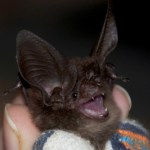extinct
Conservationists are trying hard to save the Devils Hole pupfish (Cyprinodon diabolis) from extinction. With less than 100 animals remaining, a captive breeding program was started at the University of California, Berkeley.
As you can imagine from the image below, the geographic range of this fish is smaller than other wild vertebrates. They are only found in the limestone caverns of the geothermal Devils Hole pool in Death Valley, Nevada. The pool is 3m wide, 20m long, 426 feet deep, and a very warm 92-93 degrees Fahrenheit. It is thought to have formed more than 500,000 years ago…
Image of a big-eared bat from Scientific American
The New Guinea big-eared bat (Pharotis imogene; specimen pictured above) was thought to be extinct for the past 120 years. The bat is now considered critically endangered or possibly extinct as this specimen is the only known member of the genus. Since very little is known of this endangered bat, researchers who identified this specimen suggest that further research is needed to determine its abundance and distribution. With ongoing deforestation in New Guinea, this species may very well actually become extinct.
Source:
www.…
A quick wrap-up of the animals discovered not to be extinct this week:
Armoured mistfrog
This Armoured Mistfrog, thought by many experts to be extinct due to the recent amphibian chytrid fungus epidemic, was rediscovered by my boss, enterprise search god, Chris Cleveland, while he should have been working, on CNN. And more specifically, in a remote tropical area in northern Australia.
Tadpole Shrimp
Heavy rains in Scotland have created perfect conditions for the reemergence of the tadpole shrimp, thought extinct in the UK until recently. The little critter resembles a tiny horseshoe crab…
Let's say we're having a nice day here on Earth; the Sun is shining, the clouds are sparse, and everything is just looking like a peach:
And then Lucas goes and tells me,
Oh my God, Ethan! It's Armageddon! An asteroid is coming straight for us! You've got to stop it!
Really? Me? Well, how would I do it? Let's say we've got some reasonably good asteroid tracking going on, and we've got about 2 months before the asteroid is actually going to hit us. We'd like to do something with the situation on the left, to avoid the situation on the right:
Well, what we really have to do is change the…

